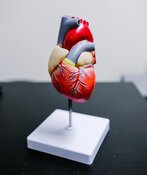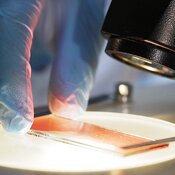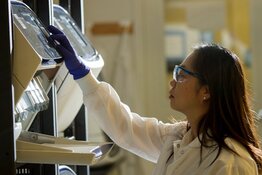Sernova Corp. and Vertex Pharmaceuticals Inc. are working on developing their own functional cure for insulin-dependent Type 1 diabetes. Here, we describe their programs, highlighting the similarities and differences.
Sernova Corp.
Regenerative medicine firm Sernova Corp. (SVA:TSX.V; SEOVF:OTCQB; PSH:XETRA), headquartered in London, Ontario, Canada, developed and is advancing its proprietary Cell Pouch, a vascularized cell-carrying bio-hybrid organ, implanted in the human body. Sernova, in its ongoing U.S. Phase 1/2 clinical trial, is assessing the treatment of patients with insulin-dependent type 1 diabetes and severe hypoglycemic episodes with donor islets implanted within the subcutaneous Cell Pouch. To protect cells from immune attack, patients are provided with an optimized immunosuppression protocol.
To deliver treatment, the Cell Pouch is pre-implanted under the skin between the deep subcutaneous muscle and the fascia, an area rich in blood vessels. The bio-hybrid organ is uniquely designed with pores into which vascularized tissue grows over several weeks post-implantation, forming a vascularized organ-like environment believed to be critical for long-term survival and function of therapeutic cells. Following the development of the organ-like environment, the cells are transplanted into its containment channels and engrafted into the surrounding microvessel-rich environment, where they read blood sugar levels and release insulin and other hormones to naturally control blood glucose levels.
Clinical trial data so far have shown the Cell Pouch to be safe and well tolerated and the treatment to be effective, reported Dr. Joseph Pantginis, H.C. Wainwright & Co. analyst, in a September research report. To date, seven patients, all six in Cohort A and one in Cohort B achieved sustained insulin independence without hypoglycemic episodes. The longest-treated patient has sustained insulin independence for four and a half years. The treatment kept these study participants' blood sugar levels controlled in the nondiabetic range (i.e.,) HbA1c less than 6.5%.
"The Cell Pouch is the most advanced encapsulation device in development," Ventum Capital Markets Analyst Stefan Quenneville wrote in a September research report.
The Cell Pouch removed from the longest treated patient showed it contained abundant functioning insulin, glucagon and somatostatin-producing islets. This is the longest period islets have been shown to survive in an implanted device in a human. There was no evidence of fibrotic tissue, material degradation, or changes in the Cell Pouch architecture. Notably, other cell devices purported to protect cells from immune attack have failed or shown poor function due either to a lack of sufficient blood vessels or to fibrotic tissue walling off the implanted device.
"We believe the impressive response rates and observed durability support Sernova's strategy and justify further investigation while positioning the technology for potential commercial success," noted Pantginis.
The results add to an expanding collection of evidence that the Cell Pouch is functioning as it should, he added. The data also support the "impressive" results already reported from this study and help derisk future related trials.
In another of its programs, Sernova, in collaboration with Evotec AG (EVTCY:OTCPK), is developing an implantable off-the-shelf, induced pluripotent stem cell (iPSC)-based islet replacement therapy, Technical Analyst Clive Maund wrote in a September report.
"This partnership provides Sernova a potentially unlimited supply of insulin-producing cells to treat millions of patients with insulin-dependent diabetes (Type 1 and Type 2)," he added.
"If Sernova is successful in bringing its functional cure for insulin-dependent diabetes to the stage where it can go into commercial production, the global market for it will be massive," wrote Maund.
Currently, Sernova's program for Type 1 diabetes requires immunosuppression, however, through partnerships, the company is developing technologies that would eliminate this need, a "blue sky objective," Douglas Loe, Leede Financial Inc. analyst, pointed out in a September research report.
"Any advances in this regard could be incorporated into future Cell Pouch studies," he wrote. "We do not consider the need for such therapy to be relevant to Cell Pouch function itself."
Vertex Pharmaceuticals
Massachusetts, U.S.-based specialty biopharma company Vertex Pharmaceuticals Inc. (VRTX:NASDAQ) is developing two approaches to treating Type 1 diabetes with stem cell-derived pancreatic islets, Loe explained in a Nov. 6 research report. The newest program, VX-264, similar in concept to Sernova's, delivers to the patient Vertex's VX-880 proprietary stem cell derived islet cells encapsulated in an implantable channel array device. Because this device is purported to be immunoprotective, unlike Sernova's Cell Pouch, immunosuppression is not needed. (The VX-264 cell platform is based on the technology of ViaCyte, which Vertex acquired in 2022, noted Loe.) Data from the ongoing trial has not yet been publicly disclosed, although the trial has been in progress for some time.
The purpose of using a cells-plus-device approach is to eliminate some issues that arise with stem cell derived beta cells transplantation technology like that used in VX-880, purported H.C. Wainwright & Co. Analyst Andrew Fein in an Aug. 2 report. One issue is that hypoxia occurs when the islets are revascularizing and relying on passive diffusion of nutrients for about a two-week period, and this causes problems with the cells and can even kill them.
The global VX-264 program is currently in Part B of Phase 1/2, with enrollment and dosing underway, as noted in a Nov. 4 news release. Part B patients receive the full target dose with a staggered period between dosing. Previously, Part A patients received a low dose with a staggered period between dosing. The study is to have a Part C as well, in which patients will receive the full target dose without staggering. Vertex expects to share initial data from this trial in 2025.
Simultaneously, the company is evaluating the infusion of its stem cell-derived, insulin-producing islet cell therapy, VX-880, into the portal vein of patients with type 1 diabetes, impaired hypoglycemic awareness, and severe hypoglycemia. Patients also receive immunosuppressive therapy, which is needed to protect the cells from immune rejection. (VX-880 is a rebranded version of the cell type Vertex gained through its 2019 acquisition of Semma Therapeutics, Loe noted.)
As for what's next for VX-880, Vertex had a successful end-of-Phase 2 meeting with the U.S. Food and Drug Administration, the European Medicines Agency, and the United Kingdom Medicines and Healthcare Products Regulatory Agency, according to the news release. The biopharma intends to advance VX-880 into pivotal development by converting the ongoing Phase 1/2 study into a Phase 1/2/3 single-dose VX-880 study, which is expected to occur in the coming months.
In the upcoming Phase 2/3, a total of 50 patients will be infused with a one target dose of VX-880. The primary endpoint is the proportion of patients with insulin independence and the absence of severe hypoglycemic episodes. Vertex has not disclosed how long the follow-up period will be, reported Loe, who wrote that he believes six to 12 months would be enough time to demonstrate clinical benefit. Final study data are expected in 2028.
Vertex has a preclinical research-stage program related to VX-880, which is assessing hypoimmune, edited, fully differentiated islet cells. These are VX-880 cells that have been edited so as to protect them from the immune system and in doing so, ideally obviating the need for immunosuppression in the clinic. According to Loe, the "hypoimmune, edited" description suggests Vertex has partnered with Sana Biotechnology Inc. regarding this initiative or has developed its own Major Histocompatibility Complex Class I/II downregulating technology "in recognition of the fact that reducing immunosuppressive burden in islet-transplanted patients will eventually be necessary to improve patient outcomes over time."
"Although the [VX-880] Phase 1/2 data are encouraging and show the proof of concept data for the concept, eventually, we think it might be the hypoimmune beta cells and/or the cells-plus-device method which might be the real growth driver for the Type 1 diabetes space," Fein wrote.
More Sector Growth Expected
The global live cell encapsulation market, encompassing drug delivery, regenerative medicine, and cell transplantation, is expected to continue growing through at least 2030, according to Grand View Research. The market's value, US$210.7 million (US$210.7M) in 2022, is forecasted to increase at a 3.97% compound annual growth rate between that year and 2030.
Along with diabetes, live cell encapsulation is being used to treat neurological disorders like Parkinson's disease, the market research firm noted. Further, it has been proven to be a suitable way to deliver treatment for other types of diseases, including cancer, anemia, heart failure and more.
Several factors are expected to keep driving market growth during the forecast period, Grand View noted. A significant one is the increasing use of live cell encapsulation in regenerative medicine to replace disease or damaged tissues. A related contributor is rising public and private funding and investments in cell and gene therapies.
The advantages of live cell encapsulation in controlled drug delivery are boosting the market, too. They include enhanced therapeutic effects, lowered drug dose, reduced cytotoxicity, improved patient convenience and better patient compliance.
Novel new products and technological advancements are expected to add value to the market as well.
The Catalysts: Clinical Trials
Both Sernova and Vertex are expected to have study updates and data readouts on their respective trials in Type 1 diabetes by year-end 2025.
As for Sernova, by the end of this year, results for the remaining Cohort B patients in its Phase 1/2 clinical trial are expected, and treatment of Cohort C will start. Patients in this latter group will receive, along with the donor islet cells, an optimized immune suppression regimen.
In 2025, Sernova plans to launch a Phase 1/2 trial assessing the iPSC-based islet cells that will result from its partnership with Evotec and will be implanted via the Cell Pouch in Type 1 diabetes patients.
In terms of Vertex, it is expected to commence its Phase 2/3 single-dose VX-880 clinical trial in the coming months. Next year, it will release initial results of its Phase 1 VX-264 clinical trial.
What the Analysts Say
Regarding Sernova, Leede Analyst Loe rates the company as a Speculative Buy. His price target on it implies a 455% return from its share price at the time of this publication.
According to H.C. Wainwright's Pantginis, the deepening responses of Type 1 diabetes patients in Sernova's Phase 1/2 trial continue to "crystallize Sernova stock's possible upside." The upside reflected in Pantginis' price target is 2,122%. His rating is Buy.
Ventum's Quenneville also has a Buy on Sernova, and his target price reflects an 826% uplift. In his report, the analyst highlighted the impressive efficacy and tolerability of the Cell Pouch up to five years post-implantation, as shown in the Phase 1/2 clinical trial data.
 Streetwise Ownership Overview*
Streetwise Ownership Overview*
Sernova Corp. (SVA:TSX.V; SEOVF:OTCQB; PSH:XETRA)
 Streetwise Ownership Overview*
Streetwise Ownership Overview*
Vertex Pharmaceuticals Inc. (VRTX:NASDAQ)
As for Vertex, Fein recently increased his target price on it by 20%. The return to the new target from the current share prices is 19%. His rating on Vertex is Buy.
The analyst assumes about 306,000 diabetic patients will be eligible for VX-800, and of those, the initial count in 2027 will be 812, increasing to 35,000 by 2031. Fein targets 2027 for a commercial launch of VX-800 in the U.S. at a cost of US$380,000. He estimates initial revenue of US$62M and increasing to US$3 billion (US$3B) by year-end 2031.
Kingswood Capital Partners has a Buy rating on Vertex and a target price on Vertex, implying an 11% uplift, according to a Nov. 7 research report.
Fundamental analyst firm, New Constructs, has a Very Attractive credit rating on Vertex. New Constructs' ratings are based on traditional ratio formulas but employ its more reliable, adjusted fundamental data in both components of each ratio.
Ownership and Share Structure
Sernova, according to Refinitiv, about 12.96% of the company is held by insiders and management, and approximately 5.0% by institutions including Evotec.
The rest is retail.
Top shareholders include Tomas Angel with 4.91%, Director Steven Sangha with 4.27%, Betty Anne Millar with 1.32%, Brett Alexander Whalen with 0.87%, and Garry Deol with 0.77%..
Sernova has 325.32M outstanding shares and 285.75M free float traded shares.
It market cap is CA$78.08M. Its 52-week high and low are CA$0.77 and CA$0.20 per share, respectively.
Vertex Pharmaceuticals, reports Refinitiv, has most of its stock, 95.44%, held by Institutions.
The top among them are Capital World Investors at 10.37%, The Vanguard Group at 8.88%, BlackRock Institutional Trust with 5.49%, State Street Global Advisors (US) with 4.55%, and Fidelity Management and Research with 4.11%.
Strategic Investors hold 0.12%.
The rest is retail.
Vertex has 257.53M outstanding shares and 257.07M free float traded shares. Its market cap us US$129.2B. Its 52-week range is US$341.90–519.88 per share.
| Want to be the first to know about interesting Medical Devices and Regenerative Medicine investment ideas? Sign up to receive the FREE Streetwise Reports' newsletter. | Subscribe |
Important Disclosures:
- Sernova Corp. has a consulting relationship with Street Smart an affiliate of Streetwise Reports. Street Smart Clients pay a monthly consulting fee between US$8,000 and US$20,000.
- As of the date of this article, officers and/or employees of Streetwise Reports LLC (including members of their household) own securities of Sernova Corp.
- Doresa Banning wrote this article for Streetwise Reports LLC and provides services to Streetwise Reports as an independent contractor.
- This article does not constitute investment advice and is not a solicitation for any investment. Streetwise Reports does not render general or specific investment advice and the information on Streetwise Reports should not be considered a recommendation to buy or sell any security. Each reader is encouraged to consult with his or her personal financial adviser and perform their own comprehensive investment research. By opening this page, each reader accepts and agrees to Streetwise Reports' terms of use and full legal disclaimer. Streetwise Reports does not endorse or recommend the business, products, services or securities of any company.
- This article does not constitute medical advice. Officers, employees and contributors to Streetwise Reports are not licensed medical professionals. Readers should always contact their healthcare professionals for medical advice.
For additional disclosures, please click here.









































